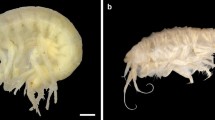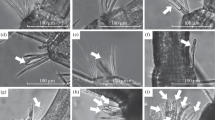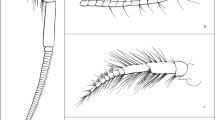Abstract
Rhizocephalans of the suborder Kentrogonida are parasitic barnacles whose female cypris larvae must locate a suitable host organism (a decapod crustacean), while the male cypris larvae must find a host containing a virgin female. Some of the sensory structures assumed to be involved in this behaviour are the aesthetasc-like setae found on antennules of the cyprids, of which the females possess one and the males two. To verify the aesthetasc nature of these setae we examined their morphology and innervation in the cyprids of the “model” kentrogonid rhizocephalan, Sacculina carcini, using SEM and TEM. No structural differences were found between the two types of aesthetasc-like setae, and their ultrastructure strongly indicates them as being aesthetascs. They have an exceedingly delicate cuticle, 20–50 nm thick, and the lumen contained essentially only very fine ciliary branches of which many were in close contact with the cuticle. No sheath cells were seen in the setal lumen. The ciliary branches could be traced back through the fourth and third antennular segment. The bodies of the sensory cells were not located, but morphological evidence suggests that their inner dendritic segments are located in the second antennular segment, giving rise to cilia that evolve into sheath-wrapped ciliary bundles. All these characteristics support their role as aesthetascs and olfactory organs, while the absence of these traits in the so-called terminal aesthetasc invalidates its previous description as an aesthetasc altogether, although it may still be a chemosensory seta.




Similar content being viewed by others
References
Ache BW (1982) Chemoreception and thermoreception. In: Bliss DE (ed) The biology of the Crustacea, vol 3. Academic, New York, pp 369–398
Blomsterberg M, Høeg JT, Jeffries WB, Lagersson NC (2004) Antennulary sensory organs in cyprids of Octolasmis and Lepas (Crustacea: Thecostraca: Cirripedia: Thoracica): a scanning electron microscopic study. J Morphol 260:141–153
Boone EJ, Boettcher AA, Sherman TD, O’Brien JJ (2003) Characterization of settlement cues used by the rhizocephalan barnacle Loxothylacus texanus. Mar Ecol Prog Ser 252:187–197
Boxshall GA, Lincoln RJ (1987) The life cycle of the Tantulocarida (Crustacea). Philos Trans R Soc Lond Ser B Biol Sci 315:267–303
Clare AS, Nott JA (1994) Scanning electron microscopy of the fourth antennular segment of Balanus amphitrite amphitrite. J Mar Biol Assoc UK 74:967–970
Clare AS, Walker G, Høeg JT (1993) The Rhizocephala. A model system for studies on the chemical basis of barnacle settlement. Environs 14:3–5
Crisp DJ (1985) Recruitment of barnacle larvae from the plankton. Bull Mar Sci 37:478–486
Derby CD (1989) Physiology of sensory neurons in morphologically identified cuticular sensilla of crustaceans. In: Felgenhauer B, Watling L, Thistle A (eds) Functional morphology of feeding and grooming in Crustacea. Balkema, Rotterdam, pp 27–48
Derby CD, Burgess MF, Olson K, Simon T, Livermore A (1994) Mechanisms of detection and discrimination of mixtures in the olfactory system of spiny lobster. In: Kurihara K, Suzuki N, Ogawa H (eds) Olfaction and taste. XI. Springer, Tokyo Heidelberg Berlin New York, pp 775–777
Derby CD, Cate HS, Gentilcore LR (1997) Perireception in olfaction: molecular mass sieving by aesthetasc sensillar cuticle determines odorant access to receptor sites in the Caribbean spiny lobster Panulirus argus. J Exp Biol 200:2073–2081
Elofsson R, Hessler RR (1994) Sensory structures associated with the body cuticle of Hutchinsoniella macracantha (Cephalocarida). J Crustac Biol 14:454–462
Garm A, Hallberg E, Høeg JT (2003) Role of maxilla 2 and its setae during feeding in the shrimp Palaemon adspersus (Crustacea: Decapoda). Biol Bull (Woods Hole) 204:126–137
Gibson PH, Nott JA (1971) Concerning the fourth antennular segment of the cypris larva of Balanus balanoides. In: Crisp DJ (ed) Proceedings of the fourth European marine biology symposium. Cambridge University Press, London, pp 227–236
Glenner H, Werner M (1998) Increased susceptibility of recently moulted Carcinus maenas (L.) from attack by the parasitic barnacle Sacculina carcini Thompson, 1836. J Exp Mar Biol Ecol 228:29–33
Glenner H, Høeg JT, Klysner A, Brodin Larsen B (1989) Cypris ultrastructure, metamorphosis and sex in seven families of parasitic barnacles (Crustacea: Cirripedia: Rhizocephala). Acta Zool (Stockh) 70:229–242
Goldman JA, Koehl MAR (2001) Fluid dynamic design of lobster olfactory organs: high speed kinematic analysis of antennule flicking by Panulirus argus. Chem Senses 26:385–398
Gomez G, Atema J (1996) Temporal resolution in olfaction. II. Time course of recovery from adaptation in lobster chemoreceptor cells. J Neurophysiol 76:1340–1343
Grygier MJ, Ito T (1995) SEM-based morphology and new host and distribution records of Waginella (Ascothoracida). In: Schram FR, Høeg JT (eds) New frontiers in barnacle evolution. Crustacean Issues 10, Balkema, Rotterdam, pp 153–178
Guse GW (1983) Ultrastructure, development and molting of the aesthetascs of Neomysis integer and Idotea baltica (Crustacea Malacostraca). Zoomorphology 103:121–133
Hallberg E, Johansson KUI, Wallen R (1997) Olfactory sensilla in crustaceans: morphology, sexual dimorphism, and distribution patterns. Int J Insect Morphol Embryol 26:173–180
Heimann P (1984) Fine structure and molting of aesthetasc sense organs on the antennules of the isopod Asellus aquaticus (Crustacea). Cell Tissue Res 235:117–128
Hipeau-Jacquotte R (1986) A new cephalic type of presumed sense organ with naked dendritic ends in the atypical male of the parasitic copepod Pachypygus gibber (Crustacea). Cell Tissue Res 245:29–35
Høeg JT (1984) Size and settling behaviour in male and female cypris larvae of the parasitic barnacle Sacculina carcini Thompson (Crustacea: Cirripedia: Rhizocephala). J Exp Mar Biol Ecol 76:145–156
Høeg JT (1987a) Male cypris metamorphosis and a new male larval form, the trichogon, in the parasitic barnacle Sacculina carcini (Crustacea: Cirripedia: Rhizocephala). Philos Trans R Soc Lond Ser B Biol Sci 317:47–63
Høeg JT (1987b) The relation between cypris ultrastructure and metamorphosis in male and female Sacculina carcini (Crustacea, Cirripedia). Zoomorphology:107:299–311
Høeg JT (1991) Functional and evolutionary aspects of the sexual system in the Rhizocephala (Thecostraca: Cirripedia). In: Bauer RT, Martin JW (eds) Crustacean sexual biology. Columbia University Press, New York, pp 208–227
Høeg JT, Kolbasov GA (2002) Lattice organs in cyprids of the Facetotecta and their significance in the phylogeny of the Crustacea Thecostraca. Acta Zool (Stockh):83:67–79
Høeg JT, Ritchie EG (1985) Male cypris settlement and its effects on juvenile development in Lernaeodiscus porcellanae Müller (Crustacea: Cirripedia: Rhizocephala). J Exp Mar Biol Ecol 87:1–11
Høeg JT, Hosfeld B, Jensen PG (1998) TEM studies of lattice organs of cirripede cypris larvae (Crustacea, Thecostraca, Cirripedia). Zoomorphology 118:195–205
Høeg JT, Lagersson NC, Glenner H (2003) The complete cypris larva and its significance in thecostracan phylogeny. In: Scholtz G (ed) Evolutionary and developmental biology of Crustacea. Crustacean Issues 15, Balkema/Lisse, Abingdon, Exton (Penn.) and Tokyo, pp 197–215
Jensen PG, Høeg JT, Bower S, Rybakov AV (1994a) Scanning electron microscopy of lattice organs in cyprids of the Rhizocephala Akentrogonida (Crustacea Cirripedia). Can J Zool 72:1018–1026
Jensen PG, Moyse J, Høeg JT, Al Yahya H (1994b) Comparative SEM studies of lattice organs: putative sensory structures on the carapace of larvae from Ascothoracida and Cirripedia (Crustacea Maxillopoda Thecostraca). Acta Zool (Stockh) 75:124–142
Johansson KUI, Gefors L, Wallén R, Hallberg E (1996) Structure and distribution patterns of aesthetascs and male specific sensilla in Lophogaster typicus (Mysidacea). J Crustac Biol 16:45–53
Kolbasov GA, Høeg JT (2003) Facetotectan larvae from the White Sea with the description of a new species (Crustacea: Thecostraca). Sarsia 88:1–15
Kolbasov GA, Høeg JT, Elfimov AS (1999) Scanning electron microscopy of acrothoracican cypris larvae (Crustacea, Thecostraca, Cirripedia, Acrothoracica, Lithoglyptidae). Contrib Zool 68:143–160
Lagersson NL, Høeg JT (2002) Settlement behavior and antennulary biomechanics and in cypris larvae of Balanus amphitrite (Crustacea: Thecostraca: Cirripedia). Mar Biol 141:513–526
Lagersson NC, Garm A, Høeg JT (2003) Notes on the ultrastructure of the setae on the fourth antennulary segment of the Balanus amphitrite cyprid (Crustacea: Cirripedia: Thoracica). J Mar Biol Assoc UK 83:361–365
Moyse J, Jensen PG, Høeg JT, Al-Yahya HAH (1995) Attachment organs in cypris larvae: using scanning electron microscopy. In: Schram FR, Høeg JT (eds) New frontiers in barnacle evolution. Crustacean Issues 10, Balkema, Rotterdam, pp 153–178
Pasternak Z, Blasius B, Abelson A (2004) Host location by larvae of a parasitic barnacle: larval chemotaxis and plume tracking in flow. J Plankton Res 26:487–493
Perez-Losada M, Høeg JT, Kolbasov GA, Crandall KA (2002) Reanalysis of the relationships among the Cirripedia and the Ascothoracida and the phylogenetic position of the Facetotecta (Maxillopoda :Thecostraca) using 18S rDNA sequences. J Crustac Biol 22:661–669
Ritchie LE, Høeg JT (1981) The life history of Lernaeodiscus porcellanae (Cirripedia: Rhizocephala) and co-evolution with its porcellanid host. J Crustac Biol 1:334–347
Rybakov AV, Korn OM, Høeg JT, Walossek D (2002) Larval development in Peltogasterella studied by scanning electron microscopy (Crustacea: Cirripedia: Rhizocephala). Zool Anz 241:199–221
Rybakov AV, Høeg JT, Jensen PG, Kolbasov GA (2003) The chemoreceptive lattice organs in cypris larvae develop from naupliar setae (Thecostraca: Cirripedia, Ascothoracida and Facetotecta). Zool Anz 242:1–20
Schmidt BC, Ache BW (1979) Olfaction: responses of a decapod crustacean are enhanced by flicking. Science 205:204–206
Snow PJ (1973) Ultrastructure of the aesthetasc hairs of the littoral decapod, Paragrapsus gaimardii. Z Zellforsch 138:489–502
Thompson H, Ache BW (1980) Threshold determination for olfactory receptors of the spiny lobster. Mar Behav Physiol 7:249–260
Walker G (1985) The cypris larvae of Sacculina carcini Thompson (Crustacea, Cirripedia, Rhizocephala). J Exp Mar Biol Ecol 93:131–145
Walker G, Lester RJG (2000) The cypris larvae of the parasitic barnacle Heterosaccus lunatus (Crustacea, Cirripedia, Rhizocephala): some laboratory observations. J Exp Mar Biol Ecol 254:249–257
Acknowledgements
Z.P. was aided by an Improving Human Potential travel grant to COBICE, Denmark, under the EU FP5, and this work is part of a dissertation towards his PhD degree. A.G. is supported by the Danish Natural Science Research Council and J.T.H. acknowledges grants from the Natural Science Research Council and the Carlsberg Foundation for microscopic equipment and a project to study Crustacea. We also wish to thank Mr. B. Bisballe, Zoological Museum, University of Copenhagen, for exquisite and always cheerful assistance with SEM operation. J.T.H. extends his thanks and professional respect to Dr. G. Walker, DSc, University of Wales, UK, for invaluable inspiration, friendship and numerous rewarding discussions. The authors declare that all experiments in this study comply with the current laws of Denmark.
Author information
Authors and Affiliations
Corresponding author
Additional information
Communicated by M. Kühl, Helsingør
Rights and permissions
About this article
Cite this article
Pasternak, Z., Garm, A. & Høeg, J.T. The morphology of the chemosensory aesthetasc-like setae used during settlement of cypris larvae in the parasitic barnacle Sacculina carcini (Cirripedia: Rhizocephala). Marine Biology 146, 1005–1013 (2005). https://doi.org/10.1007/s00227-004-1494-4
Received:
Accepted:
Published:
Issue Date:
DOI: https://doi.org/10.1007/s00227-004-1494-4




